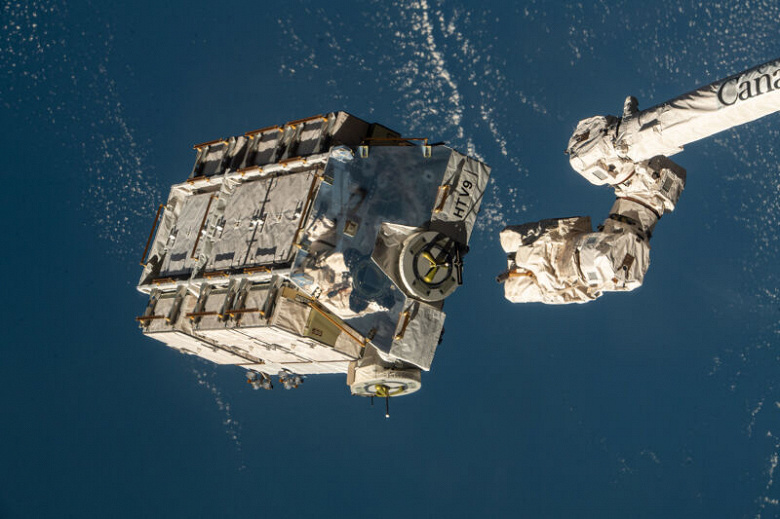This became the largest object “ejected” from the ISS
The ISS's exhausted batteries spent nearly three years in Earth's orbit before plunging into the atmosphere on Friday. It is possible that some fragments of the batteries were able to reach the surface of the planet, although most of the debris burned up upon entry into the atmosphere.
Space debris, including debris, spent satellites and rocket stages, periodically fall to Earth. In this case, we are talking about the ISS battery tray, which weighs more than 2.6 tons. NASA intentionally left this debris on an uncontrolled reentry path after careful analysis and assurance of its safety.
Sandra Jones, a NASA spokeswoman, said the agency conducted a detailed analysis and concluded the pallet would safely return to Earth's atmosphere. It is the most massive object ever ejected from the ISS.
According to the US Space Command, the batteries entered the atmosphere on Friday at 14:29 Eastern Standard Time. They were expected to fly between Mexico and Cuba.
The European Space Agency (ESA) also monitored the pallet's trajectory. In a statement last week, the ESA said the risk of a person being struck by parts of the pallet was “very low” but acknowledged that some parts could have reached the Earth's surface. Astrophysicist Jonathan McDowell suggested that about 500 kilograms of debris could reach the Earth's surface. Typically, 20% to 40% of a large object's mass reaches the ground, depending on its design.
The batteries were launched on the Japanese cargo ship HTV in 2020 and served to replace obsolete nickel-hydrogen batteries. Two-armed robot «Dextr» station, with the help of astronauts during spacewalks, replaced outdated batteries with modernized ones. Nine old batteries were installed on the HTV's cargo pallet before it was released from the station's robotic arm.
The space station's robotic arm undocks a cargo pallet containing batteries from the ISS on March 11, 2021. The batteries have been drifting in orbit ever since. Low Earth orbit is self-cleaning due to aerodynamic drag. The drag of tenuous air molecules in low Earth orbit gradually slowed the pallet's speed until, finally, Friday, gravity sent it flying into the atmosphere.
NASA chose to discard the batteries during an uncontrolled re-entry rather than recycle them. Although today, when launching satellites, NASA requires that launch providers reserve enough fuel to remove the upper stage of the rocket from orbit or transition to a safe trajectory so as not to interfere with other spacecraft.
After delivering cargo to the ISS, cargo ships leave the station with garbage and unnecessary equipment. Thus, SpaceX's Dragon capsule delivers this debris to Earth, and automated supply ships from Northrop Grumman and Roscosmos dispose of the debris through controlled destruction over the ocean. Japanese HTV cargo ships performed a similar role during nine flights to the ISS. There were a total of four Japanese resupply missions that delivered ?63~24 upgraded lithium-ion batteries to the ISS as part of a mid-life upgrade of the laboratory's electrical system. The original plan was for the old batteries to be disposed of on the same HTV ship that brought the new batteries. However, some of the old batteries were left at the station for long-term storage as spare ones.
In the past, NASA has followed a plan to remove new batteries from the HTV's cargo pallet, replace the old batteries, and return the pallet to the ship before departure. However, after the unsuccessful launch of «Soyuz» in 2018, NASA astronauts Nick Hague and Russian commander Alexei Ovchinin failed to reach the ISS and the plan was aborted. The crew members landed safely in Kazakhstan, and Hague was to assist with the installation of new batteries, delivered to the station ??several weeks earlier by the HTV cargo ship.
With Haig still on the ground, the station's robotic arm removed the battery tray from the HTV and placed it in temporary storage until a new team of astronauts was ready to install them. The robotic arm then freed the Japanese supply ship to complete its mission. This interrupted the battery replacement cycle, and each subsequent HTV mission left the station ??with the cargo pallet left behind by the previous HTV. This caused the ISS battery replacement cycle to be interrupted.
But the HTV program ended in 2020, and none of the other cargo ships are designed to accommodate a battery tray. Japan's new HTV-X cargo spacecraft had yet to launch a single launch, so there was no means to dispose of the last tray of nine batteries.
Without its own thrust, the pallet cannot be directed into the atmosphere over a deserted area. The ISS orbits between 51.6 degrees north and south latitude. US Space Command had set a six-hour forecast for the pallet's re-entry, which was later narrowed to four hours. The sabot eventually entered the atmosphere at 2:29 p.m. Eastern Standard Time. As a result, most of the battery equipment burned out, and the remaining debris fell into the sea.

